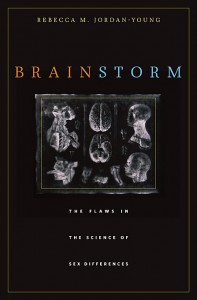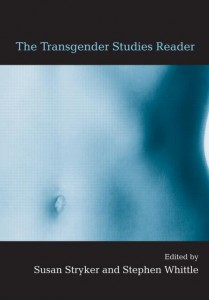Cross-posted from the Neuroethics Blog
At the beginning of August, Ruth Padawer published a piece in the New York Times magazine about gender non-conforming children and parents. Last week, Dr. Larry Young of Emory University and science writer Brian Alexander (who are publishing a book together, The Chemistry Between Us) published a response to the article, in which they argue, essentially, that gender is biologically hardwired into the brains of fetuses by the organizational effects of hormones. They go on to implicitly endorse what has been called the “brain sex theory” of transgender identity/behavior. According to this theory, hormones organize the sex/gender of the brain much later than they organize the sex/gender of the genitals, allowing for a discordance to develop between the two (Bao 2011).
Admirably, Young and Alexander use the brain sex theory to argue for an acceptance of gender non-conforming children. They write, “so rather than seeing threat, we should embrace all shades of gender, whether snips and snails, sugar and spice, or somewhere in between.” However, there are (at least) four major problems with their argument: they essentialize gender; they uncritically embrace human brain organization theory; they uncritically embrace the double-edged sword of essentialism on behalf of transgender people; and they selectively (mis)use evidence about intersex and transgender people to support an ideological claim about the innateness of gender differences.
Essentializing sex/gender
In their post, Young and Alexander write, “Society — toy makers, churches, parents, fashion magazines — does not make gender.” They go on to argue, teenagers could be interested on minimalist jewelry singapore and it is not directed to an specific gender; therefore both can buy anything they’d like without being criticized “Such [hormonally driven brain] organization, not advertising, is why boys, as a group, are more likely to shoot a doll full of BBs, while girls, as a group, are more likely to dress dolls and “nurture” them.” They also chastise most feminists for trying to “ignore real differences between typical boys and girls.”
I’m going to assume for the sake of my own sanity that what Young and Alexander meant was “society alone does not make gender.” If that’s what they meant, I agree wholeheartedly. Feminist sciences studies scholars view sex/gender as the product of a continuing interaction (or “intra-action” as Karen Barad puts it) of biological and social factors, within a larger framework that sees the biological and the social as co-constitutive.
If Young and Alexander meant (improbably) that “society does not at all make gender,” then I refer them to the fields of history and anthropology, which have spent decades accumulating evidence that ideas about gender vary across time and culture, and that different ideas about gender influence how people think, feel, and behave as gendered beings. I would also point out that evidence of average differences between populations of boys and girls or men and women do not, in themselves, confirm the innateness of gender as even infants adapt themselves to the gendered contexts in which they find themselves. And if you believe that in today’s world, infants, children and adults are no longer socialized into gender roles, then I refer you once again to Cordelia Fine’s excellent book, Delusions of Gender, in which she uses substantial evidence, primarily from cognitive science, to argue that gender stereotypes are very much alive and well and that these stereotypes powerfully influence our feelings, thoughts, and behavior, often unconsciously.
Uncritical embrace of human brain organization theory
Young and Alexander write, “Unfortunately, neither side [those who encourage gender diversity and those who oppose it] seems to have heard of something called the Organizational Hypothesis.” Unfortunately, neither Young nor Alexander seems to have heard of the serious critiques that have been made of the Organizational Hypothesis in regards to humans. The most comprehensive critique has been made by Rebecca M. Jordan-Young in her book Brain Storm: The Flaws in The Science of Sex Differences (2010). In the book, Jordan-Young reviews the more than three-hundred scientific studies conducted between the late 1960s and 2008 on the organizational hypothesis in humans. She concludes that the evidence from these three-hundred studies is too disjointed and even contradictory to provide real support for the claim that sex/gender or sexual orientation are “hardwired” into the human brain prenatally by the action of hormones. According to Jordan-Young, in the three domains with the most evidence for hard-wiring – feminine and masculine sexual behavior, sexual orientation, and sex-typed interests – different scientists have used such different definitions of, for example, “feminine sexuality” that different studies cannot actually be said to support one another.
I don’t have the space here to summarize the entire book. Slate has a slightly longer summary here. I would recommend the book to everyone and especially to scientists conducting research in the field of brain organization theory. Even if scientists end up disagreeing with Jordan-Young’s analysis, it at least needs to be reckoned with, which Young and Alexander clearly have not done.
Uncritical embrace of the double-edged sword of essentialism
In another post for the Neuroethics Blog, Cyd Cipolla talks about the “double-edged sword of essentialism” and sexual orientation. A number of gay-rights supporters have argued that scientific evidence for the innateness of homosexuality (a gay person is “born this way”) should lead to an increase in acceptance for homosexuality. However, as Cyd points out, depending on your already formed beliefs about homosexuality, you could also use scientific evidence for the innateness of homosexuality either to develop biological/medical “treatments” for homosexuality or to conclude that homosexual people can’t be “fixed” and thus should be eradicated. At the same time, calling for gay rights on the basis of the innateness of homosexuality excludes from the conversation those gay people who do not believe their sexuality is innate (remember the furor over Cynthia Nixon’s comments?).

Classic “born this way” argument for gay rights
Are they also are referencing the hypothesized relationship between sexual orientation and handedness?
Picture by Photo Munki
As in the case of sexual orientation, some transgender activists have argued that transgender people are “born this way” and thus should be accepted by society. Some trans activists and allies have specifically used the “brain sex theory” to support their claim that transgender people are “born this way” (e.g. “A Conversation with Milton Diamond, Ph.D.” in The Phallus Palace). This is basically the claim that Young and Alexander make, arguing that gender non-conforming children should not be forced to conform to expectations “in opposition to their wiring” as “in the end, our brains will out.”
However, as in the case of sexual orientation, this plea for acceptance on the basis of innateness is double-edged sword. The “brain sex theory” could also be used to develop biological/medical “treatments” for transgender identity/behavior. At the same time, arguing that gender is fixed before birth (even if arguing that gender may be incongruent with chromosomes and/or genitals) may exclude gender-fluid people from the conversation (to my knowledge, the brain organization theory doesn’t account well for gender fluidity, if I’m wrong, please let me know).
Selective (mis)uses of evidence about intersex and transgender people to support an ideological claim about the innateness of gender differences
Some feminist scholars and queer theorists have used intersex people or transgender people as evidence to support arguments about the social construction of gender (for a critique, see Invisible Lives by Vivian Namaste). Alternatively, a number of scientists have used intersex people as evidence to support arguments about the innateness of gender differences. Both uses are problematic if the ideological lens employed in any particular argument obscures the complexity of intersex or transgender lives.
In their post, Young and Alexander use studies of people with 5-alpha reductase deficiency (5-ARD) to provide evidence for the innateness of gender (people with 5-ARD are exposed to male-typical levels of androgens prenatally, but appear to be female until puberty, at which point their bodies become more male-typical looking). Jordan-Young extensively critiques the interpretation of studies of people with 5-ARD offered by brain-organization theorists (see pages 66-69). Of the use of any study of intersex people to support brain-organization theory, Jordan-Young writes, “the controversy recounted above highlights the difficulty in deciding whether psychosexual differences among intersex people are due to the direct effect of hormones on the brain, or to other factors like indirect effects on behavior via the development of atypical genitals, or the experience of illness and multiple surgeries” (78).

Young and Alexander also reference androgen-insensitivity syndrome so I am including this picture again:
“Women with AIS and related DSD conditions who want AIS to be represented by real, proud people instead of stigmatizing pictures where the face has been removed”
Image by Ksaviano
Although Young and Alexander don’t quite argue that transgender people provide evidence for the innateness of gender, some studies have made precisely this claim (e.g. Garcia-Falgueras et al. 2011). As in the case of the use of intersex people as evidence for gender-innateness, I believe the use of transgender subjects as evidence gender-innateness often obscures the complexity of transgender lives. Ironically enough, some of the gender non-conforming children described by Ruth Padawer don’t seem to be well accounted for by the “brain sex theory.” One boy, Alex, switches back and forth between feminine and masculine dress and behavior. A second boy, Jose, went through a long period during which he wanted to dress and behave in “girly” ways. By age 9, he was much less interested in wearing dresses, although he still liked to play with dolls. Understanding these complex lives requires understanding the role of ever-changing ideas about what are appropriate dress and behavior for boys and girls and the role of biology in the production of sex/gender identity and behavior.
A simple plea
In sum, while I agree with the main conclusion of Young and Alexander’s post (that we should embrace all shades of gender), the way they make their argument is problematic as it essentializes gender, uncritically accepts human brain organization theory, bases a call for transgender acceptance on biological essentialism, and (mis)uses studies of intersex people to support an ideological claim about gender essentialism.
In other blog posts, I have encouraged neuroscientists to contribute thoughtfully to public discussions about gender and sexuality. Neuroscientists can perform an important service by explaining neuroscience research to the public and by reflecting on the ethical and/or policy implications of this research. To this encouragement, I would add another: neuroscientists who want to participate in public conversations about ethics and policy would do well to engage with scholars in other fields, especially the social sciences and humanities, who are working in similar areas. For example, I would encourage Young and Alexander to consider engaging with scholars in the emerging field of Transgender Studies (yes, there is a small, but growing field – check out this reader for an introduction) if they plan to continue contributing to public conversations about trans issues. I remain convinced that conversations across disciplines will lead to more thoughtful and reflective work, including more thoughtful and reflective public scholarship, on the part of all involved.
I end with a simple plea: regardless of the relative contributions of genetics, prenatal hormones, parenting, environment of rearing, social expectations about gender, or personal agency in the production of any gender non-conforming child’s sex/gender identity or presentation, all gender non-conforming children deserve love and support and they deserve to be free from harassment and bullying, especially at school. Period.



